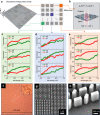Disordered metasurface enabled single-shot full-Stokes polarization imaging leveraging weak dichroism
- PMID: 37935685
- PMCID: PMC10630513
- DOI: 10.1038/s41467-023-42944-6
Disordered metasurface enabled single-shot full-Stokes polarization imaging leveraging weak dichroism
Abstract
Polarization, one of the fundamental properties of light, is critical for certain imaging applications because it captures information from the scene that cannot directly be recorded by traditional intensity cameras. Currently, mainstream approaches for polarization imaging rely on strong dichroism of birefringent crystals or artificially fabricated structures that exhibit a high diattenuation typically exceeding 99%, which corresponds to a polarization extinction ratio (PER) >~100. This not only limits the transmission efficiency of light, but also makes them either offer narrow operational bandwidth or be non-responsive to the circular polarization. Here, we demonstrate a single-shot full-Stokes polarization camera incorporating a disordered metasurface array with weak dichroism. The diattenuation of the metasurface array is ~65%, which corresponds to a PER of ~2. Within the framework of compressed sensing, the proposed disordered metasurface array serves as an efficient sensing matrix. By incorporating a mask-aware reconstruction algorithm, the signal can be accurately recovered with a high probability. In our experiments, the proposed approach exhibits high-accuracy full-Stokes polarimetry and high-resolution real-time polarization imaging. Our demonstration highlights the potential of combining meta-optics with reconstruction algorithms as a promising approach for advanced imaging applications.
© 2023. The Author(s).
Conflict of interest statement
The authors declare no competing interests.
Figures






References
-
- Coffeen DL. Polarization and scattering characteristics in the atmospheres of earth, venus, and jupiter. J. Opt. Soc. Am. 1979;69:1051–1064. doi: 10.1364/JOSA.69.001051. - DOI
-
- Pors A, Nielsen MG, Bozhevolnyi SI. Plasmonic metagratings for simultaneous determination of Stokes parameters. Optica. 2015;2:716–723. doi: 10.1364/OPTICA.2.000716. - DOI
LinkOut - more resources
Full Text Sources

